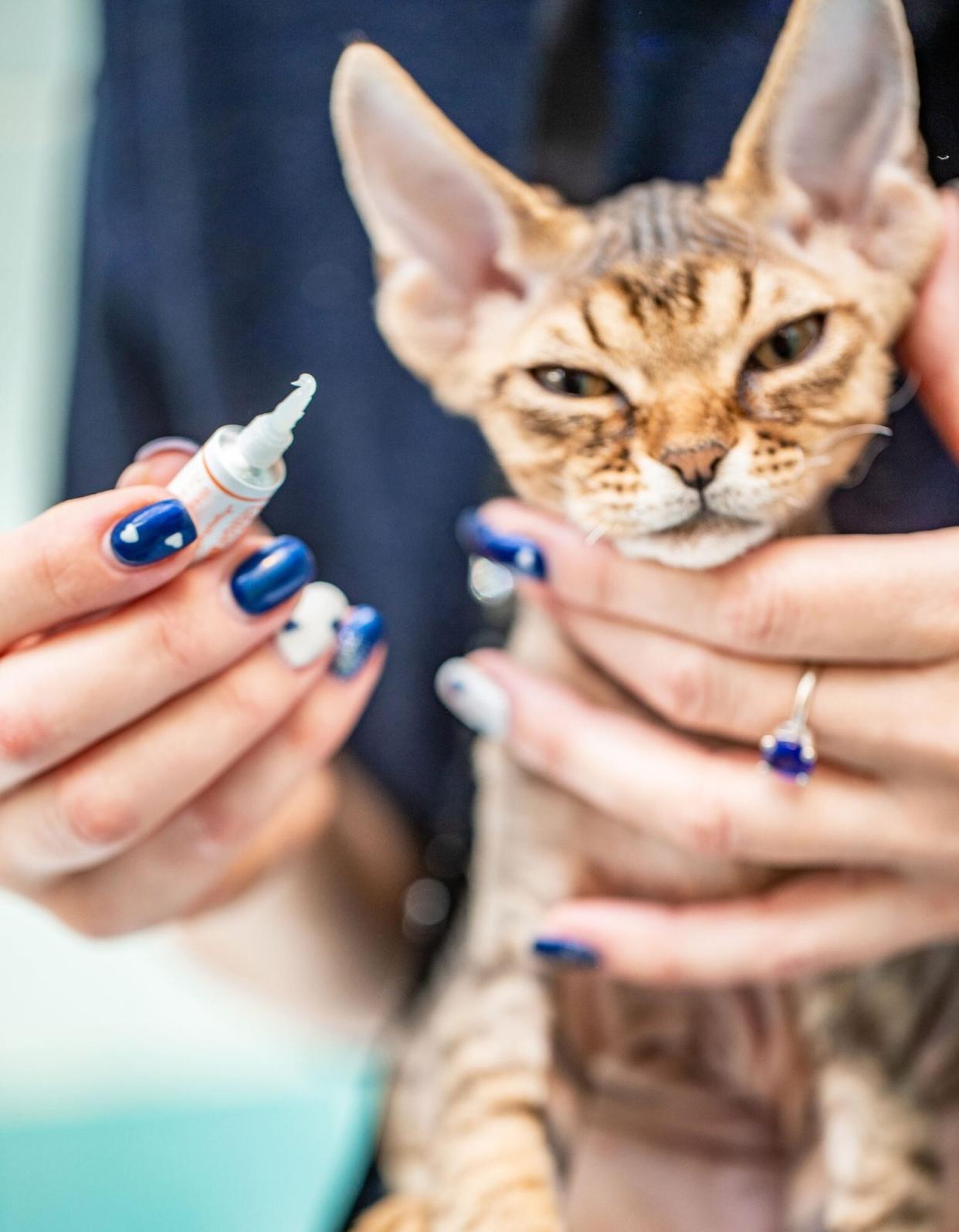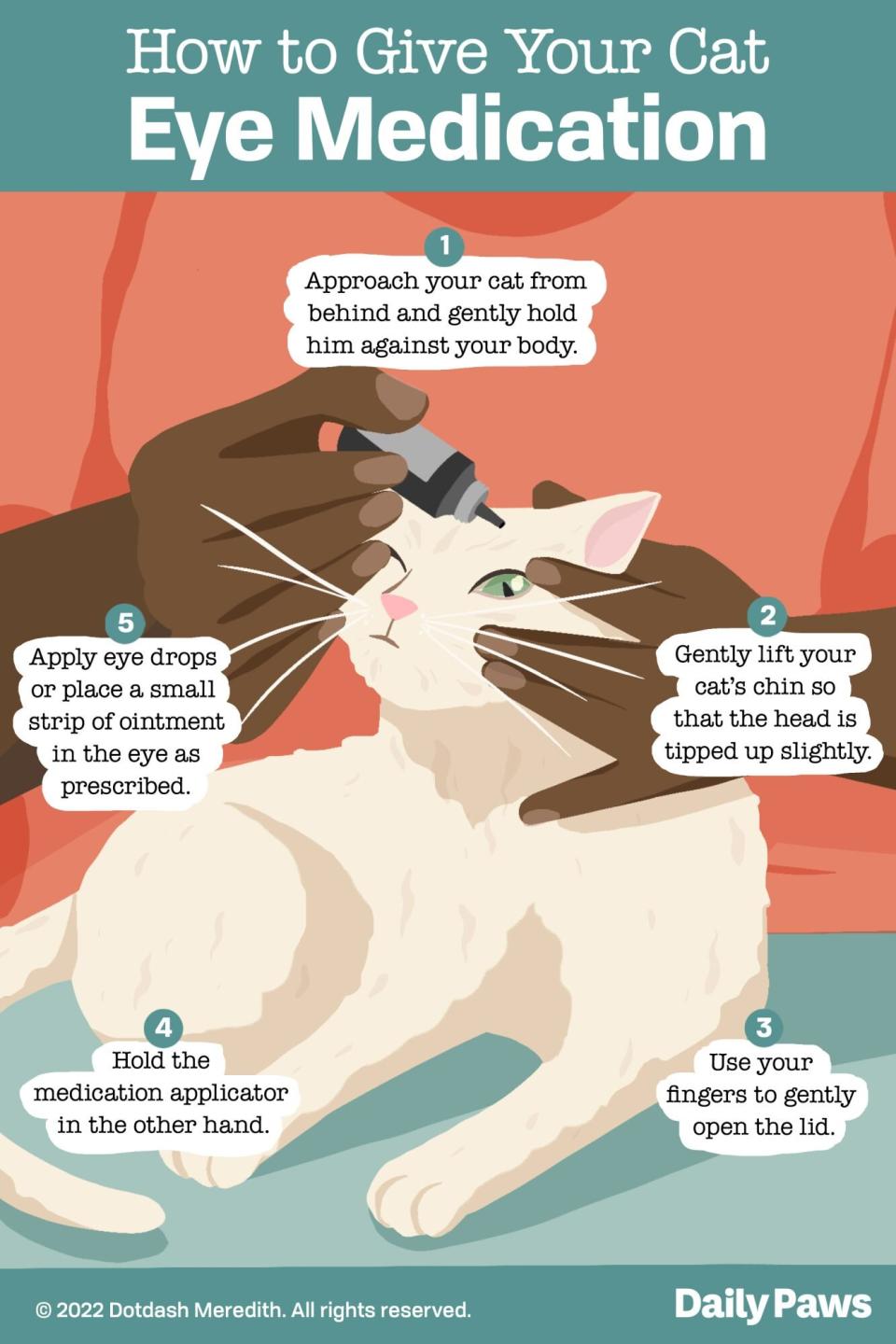Cat Eye Infection Treatment: How To Administer Drops and Ointments

CasarsaGuru / Getty
TABLE OF CONTENTS
On This Page
Eye Infections in Cats
Treatments
How to Give Your Cat Eye Drops
How to Give Your Cat Eye Ointments
Other Important Tips
Unfortunately, a veterinarian has diagnosed your cat with an eye infection. Oof! Now the tricky part begins. It's hard to keep all of those eye medications straight, not to mention actually getting the medication into your cat's eyes. Here are some tips and tricks to ensure your feline family member gets the cat eye infection treatment they need.
Eye Infections in Cats
Eye infections in cats are a common medical concern, and they can be quite painful and irritating. Common signs of an eye infection include:
Eye discharge (clear, yellow, or green)
Squinting and blinking a lot (blepharospasm)
Inflammation of the pink tissue around the eye (conjunctivitis)
Eye redness
Rubbing at the eyes with their paws
Most commonly, eye infections in cats are secondary to upper respiratory infections, but other cat eye problems can have a similar appearance or cause a secondary infection.
Treatments for Cat Eye Infections
Eye infection treatment for cats involves administering medications directly onto the eye itself or giving oral medications. These medications may be antibacterial or antiviral.
Topical eye medications typically come in the form of a solution or an ointment. Oral medications are often liquid, but your vet may prescribe a pill.
Common medications that go topically on the eye for eye infections include:
Neomycin, polymyxin B, and bacitracin (or gramicidin), which is a triple antibiotic (antibacterial)
Oxytetracycline hydrochloride, commonly known as Terramycin (antibacterial)
Gentamicin (antibacterial)
Idoxuridine (antiviral)
Oral medications are often geared toward treating an underlying respiratory infection. Examples include:
Doxycycline (antibacterial)
Azithromycin (antibacterial)
Famciclovir (antiviral)
Importantly, don't use a human triple antibiotic, such as Neosporin, for your cat's eye infection. Cats have been known to have life-threatening anaphylactic responses to triple antibiotics intended for human use.
If your cat has another eye condition, such as glaucoma, they may receive other eye medications we haven't discussed.
RELATED: 5 Scratch-Free Ways to Give Your Cat a Pill

Kailey Whitman
How to Give Your Cat Eye Drops
Administering eye drops for cats can be quite difficult and is often a two-person task! Consider asking for backup if you find yourself having to give your cat medication, especially medications that go into the eye.
With eye solutions, you'll usually be placing one drop into the affected eye a prescribed number of times per day.
To administer an eye drop:
Approach the cat from behind so that you can gently hold the cat against your body while administering the medication.
Gently lift your cat's chin so that the eye is more horizontal or parallel to the ground. This position allows the drop to fall into the eye.
With the hand that is holding up the chin, gently pull down the cheek to lower the lid.
Hold the drug applicator in your other hand.
Using whichever hand is most comfortable, apply gently open the upper lid.
Lightly squeeze the bottle to release a drop of solution onto the surface of the eye, but don't let the applicator tip touch the eye.
Keep in mind that one drop of medication is usually more than adequate, so if some runs out of the eye, this is normal. If you get most of the drop in the eye, you're more than likely doing very well!
How to Give Your Cat Eye Ointments
Ointments are notoriously more difficult to give to cats than drops, so be prepared to ask for help with administration.
With ointments, the vet may tell you to place a small strip (about one-eighth to one-fourth inch) of the ointment into the eye a prescribed number of times per day.
When administering ointments, you can use the same process as for drops, but your focus should be on lowering the lower lid. It can be helpful to think of yourself as placing the medication within the lower eyelid. If you do this, the medication will distribute onto the eye when the cat blinks. However, if your cat is not tolerating this, it's better to get the medication somewhere on the cornea than nowhere at all.
RELATED: How Many Eyelids Do Cats Have? Here's What a Cat Eye Doctor Says
Other Important Tips for Administering Eye Medications
When administering eye medications, keep in mind the following tips:
If you're giving multiple eye medications, your veterinarian should tell you the appropriate order of administration. Typically, you'll want to go from least to most viscous, meaning it's best to give solutions or drops prior to giving ointments.
Wait five minutes between each eye medication to allow the previous medication to absorb.
Whether you're giving drops or ointments, you don't want to touch the surface of the eye with the applicator. You could accidentally cause trauma to the cornea or spread infection between the eyes. Instead, you want the medication to fall into the eye.
If your cat has significant eye discharge, you can gently wipe the discharge away with a moistened cotton ball or warm compress prior to applying medications.
If your cat is rubbing at their eye, consider placing an e-collar on them to prevent them from injuring their eye.

